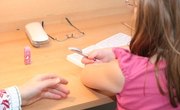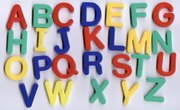Phonics provides students with tools to decode word pronunciations, meanings and spellings. Phonics training aids a student to become an independent reader and write intelligible sentences and essays and aids the non-English native student in decoding the written word as he learns to speak the language. Fourth grade phonics builds on previously taught skills and provides valuable tools for the challenged reader and English language learners.
Vowel Diagraphs
Fourth-graders work with vowel diagraphs, two-vowel combinations that affect how a word is pronounced and spelled. Common vowel diagraphs include ”ie,” “ea,” “ou,” “ow,” “au,” “oi,” “oy,” “ew” and doubled vowels such as “ee” and “oo.” Students learn phrases such as “when two vowels come walking the first one does the talking” to explain that the second vowel is often silent. The fourth-grader also learns exception rules such as “i before e except after c and in words like ‘neighbor’ and ‘weigh’.” Rhyming groups of words such as blue, clue, true and due reinforces vowel diagraphs and allows students to use the words to construct poems. Worksheets using the diagraphs and possible consonants and consonant groups also work well for teaching the sounds.
Consonant Diagraphs and Blends
As with vowel diagraphs, consonant diagraphs are common pairs of consonants that make a different sound than each consonant alone. For example, fourth-graders learn to recognize and sound out diagraphs such as “ch,” “th,” “sch,” “ph” and “gh.” Consonant blends include letter groups such as “fl,” “bl,” “pr” and ”tr.” Students may learn blends faster because the consonants retain their normal sound. Add words that demonstrate the diagraph in reading assignments and spelling lists. Instruct students to raise a hand when words with the week’s diagraph are spoken or to use the words appropriately in sentences.
Compound Words
Fourth-graders learn that compound words such as baseball, railroad, inside and outside are written as a single word. Include these words in vocabulary lists and on worksheets. Students discover that they may commit these words to memory to correctly identify them on practice sheets and tests. Provide a list of common compound words for student reference or include these in spelling lists.
Prefixes, Suffixes and Roots
Fourth-graders explore Greek and Latin prefixes and suffixes to build complex words such as biology, transport, flexible, telephone, spectacle and autograph. Students learn the meanings of prefixes and suffixes so they can decode a complex word and guess its meaning, even if they have not seen the word previously. Give students a list of common prefixes and suffixes to define. Have students make as many compound words as possible with the supplied list. They may think of other words using the same prefixes and suffixes.
Silent Letters
Fourth-graders review silent letter rules such as the silent “e” at the end of words like bone, care and ripe and the silent second consonant in words with a double “s” or “l.” They learn that certain letter groupings include silent letters such as “kn,” “wr,” “ght” and “gn” in words such as know, write, height and sign.
Related Articles
References
Writer Bio
Rev. Kathryn Rateliff Barr has taught birth, parenting, vaccinations and alternative medicine classes since 1994. She is a pastoral family counselor and has parented birth, step, adopted and foster children. She holds bachelor's degrees in English and history from Centenary College of Louisiana. Studies include midwifery, naturopathy and other alternative therapies.











